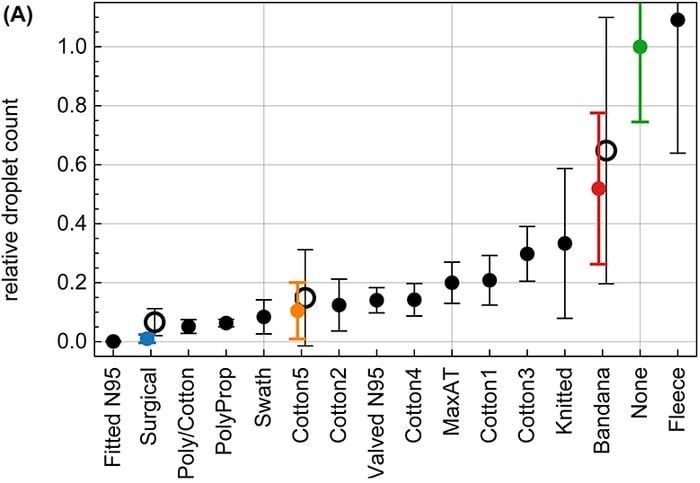Study Suggests That Some Masks Are Much Better than Others

A new study on masks that measures the number of droplets emerging from the mouth during speech shows that properly fitted N95, surgical, and polypropylene masks are best, layered cotton masks are good, bandanas are not great, and neck gaiters may be worse than wearing no mask. Here’s a Washington Post article about the study.
I have some issues with this study — most masks were tested by only one speaker and mask materials were not identified precisely1 — but when combined with other studies about masks, it is clear that surgical masks or masks that are made with similar materials (polypropylene non-woven fabric) are what you want to shoot for, you want multiple layers for more protection (no single-layer microfiber gaiters), homemade cotton masks are pretty good (but would be better with a layer of polypropylene non-woven fabric), proper fit matters, and for god’s sake, stop wearing a bandana as a mask. Yes, bandanas are convenient, but you’re probably trading safety for that convenience, especially if you factor in the amount of time you’ll be wearing a mask over the next several months. A proper mask is going to protect you and your neighbors much more over the long haul — it’s just common sense at this point.
Re: the tested neck gaiter being worse than wearing no mask: the hypothesis is that the gaiter’s material splits large droplets into smaller ones, hence the higher count.
We noticed that speaking through some masks (particularly the neck fleece) seemed to disperse the largest droplets into a multitude of smaller droplets (see Supplementary Fig. S5), which explains the apparent increase in droplet count relative to no mask in that case. Considering that smaller particles are airborne longer than large droplets (larger droplets sink faster), the use of such a mask might be counterproductive.
Here’s what I’m taking away from this and other mask studies: wear the highest quality mask you can locate (multi-layered, incorporating surgical mask materials) that fits properly and, secondarily, is comfortable & convenient. For me, that’s a two-layer cotton mask (like these Vida masks) with an inserted layer of polypropylene non-woven fabric. An N95 would be much better in terms of efficacy, but it’s overkill in most situations (particularly here in VT, where rates continue to be low) and is difficult to fit properly and quickly. (via @EricTopol)
Update: Slate’s Susan Matthews goes into more detail about the problems with this study and the conclusions that others are drawing from it.
The purpose of the research was to establish that the testing method worked in principle-not to come up with meaningful or accurate verdicts about particular masks.
But she also concludes (correctly, in my mind):
Should you think twice about wearing just a gaiter inside, in close proximity to other people? Yeah, a fitted mask is probably better. But you didn’t need this study to tell you that.
(via @BrianDau)
Update: But interesting to note that in this test, scarves, bandanas, and microfiber neck gaiters came in last.
What is a “gaiter type neck fleece” made out of exactly? If you look at the photo, it doesn’t look like fleece so much as microfiber polyester, which is what my kids wear for skiing. This article says the neck gaiter was “made of polyester mixed with a little spandex”, which is definitely not fleece. My guess is they tested a one-layer microfiber gaiter and that higher quality gaiters would perform better (but still not as well as a surgical mask).↩





Stay Connected